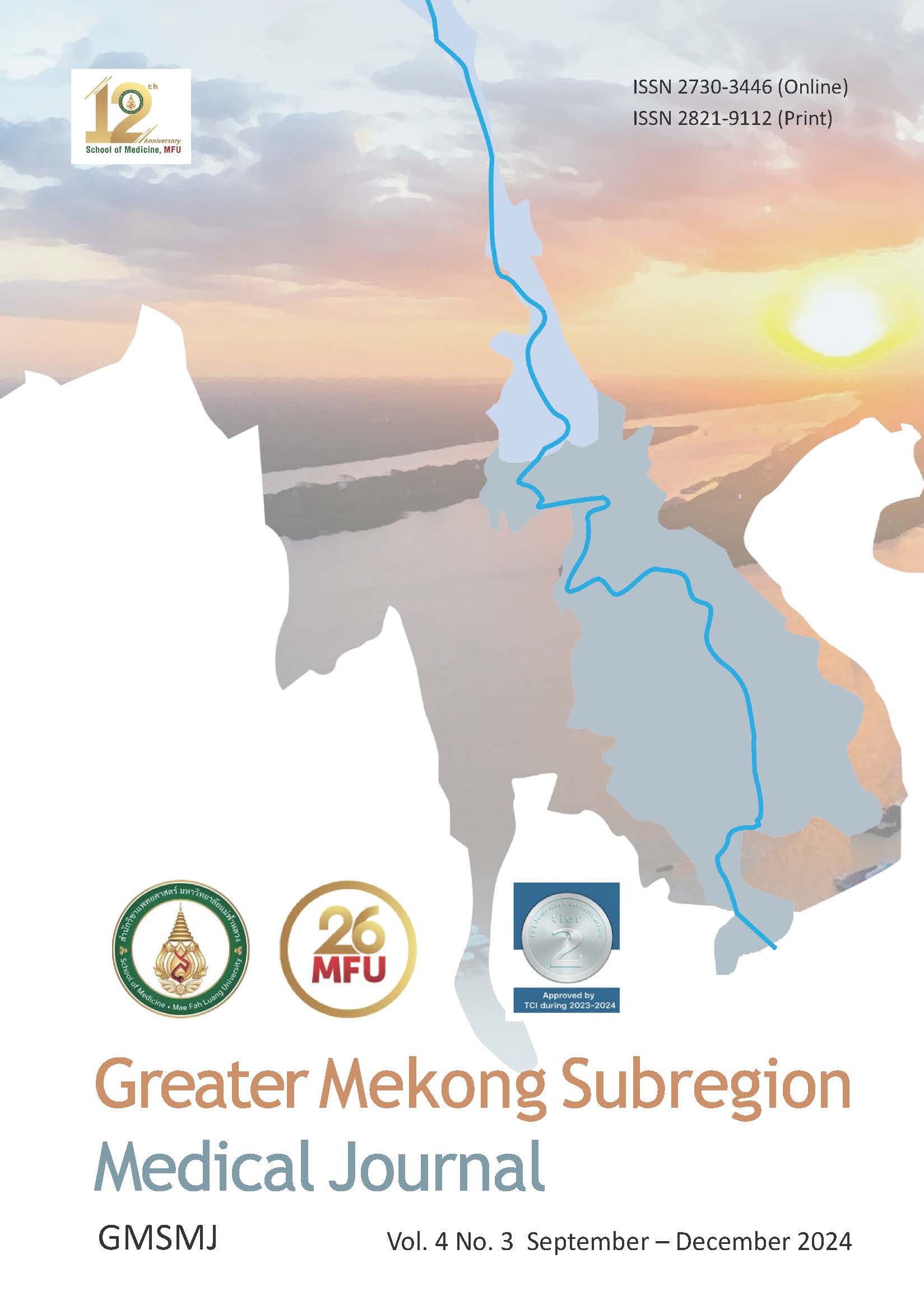Physical and Chemical properties of Medical Lubricant Made from Rice Starch
Keywords:
Rice starch, Medical lubricant, Gelatinized, Water soluble, ViscosityAbstract
Background: Gel lubricants belong to pharmaceuticals that are included in the cost of diagnostics. This material is pharmaceutical product in gel form that has been synthesized for medical or veterinary use. It is a lubricant for various body parts for surgery, physical examination, or as a reduced friction agent between the body and medical equipment. Normally, this product must be imported from foreign contries billions baht per year.
Objective: This research aims to produce medical lubricant gel from rice starch, a Thai agricultural raw material that helps reduce the problem of importation from abroad.
Materials and Method: The main raw material is pure rice starch, pharmaceutical grade added in different amounts of 37%, 54%, 63%, 70%, and 80% by weight mixed with additives. These additives are sodium hydroxide, carboxyl-methyl cellulose, sucrose, glycerin, and methylparaben. The method of combining the solution with the solution determines the physicochemical characteristics of commercial lubricant gel, compared with the gel samples of this research by using the SEM-EDS technique, pH analysis, and the FTIR technique.
Results: The results showed that the acidity and alkalinity of the two commercial gels compared to the sample gel. The pH is in the range between can be used according to ISO 13485: 2003 in the same range, pH 6-7. The morphology of the commercial gel found that the lubricant gel from the rice starch was uniformly distributed in the structure of the gel. The viscosity of the commercial lubricant gel is 2,991 ± 60.92 cP. This value is near the viscosity of gel 80 wt% of rice starch was 2,936 ± 18.52 cP. The chemical composition of the commercial gels consists of the carbon and oxygen function groups. However, the FTIR technique found amounts of synthetic substances such as sulfur, chloride, nitrogen, and zinc, which may irritate to skin. Meanwhile, the rice gel of this research found that there are carbon compounds, oxygen, and sodium, which are more than 95% organic compounds, and therefore 100% safe.
Conclusion: The study of lubricating gel made from rice starch by finding the physical, chemical, and biological properties. This project found that rice lubricant gel contains 80% of rice starch by weight. It is the best ingredient which has the same safety and lubrication performance as a commercial gel. Therefore, lubricant gel from rice starch can replace the gel ordered from abroad.
References
Information on https://en.wikipedia. org/wiki/Surgical_lubricant.
Pavelic Z, Skalko-Basnet N, Jalsenjak I. Characterisation and in vitro evaluation of bioadhesive liposome gels for local therapy of vaginitis, Int. J. Pharm. 2005; 301: 140-8. https://doi.org/10.1016/j.ijpharm.2005.05.022
das Neves J, Bahia MF. Gels as vaginal drug delivery systems, Int. J. Pharm. 2006; 318: 1-14. https://doi.org/10.1016/j.ijpharm.2006.03.012
das Neves J. Amaral MH, Bahia MF. Performance of an in vitro mucoadhesion testing method for vaginal semisolids: Influence of different testing conditions and instrumental parameters, Eur. J. Pharm. Biopharm. 2008; 69: 622-32. https://doi.org/10.1016/j.ejpb.2007.12.007
das Neves J, da Silva MV, Gonçalves MP, Amaral MH, Bahia MF. Rheological properties of vaginal hydrophilic polymer gels. Curr. Drug Deliv. 2009; 6: 83-92. https://doi.org/10.2174/156720109787048294
Geibel S. Condoms and condiments: Compatibility and safety of personal lubricants and their use in Africa, J. Int. AIDS Soc. 2013; 16:18531. https://doi.org/10.7448/IAS.16.1.18531
Voeller B, Coulson AH, Bernstein GS, Nakamura RM. Mineral oil lubricants cause rapid deterioration of latex condoms. Contraception. 1989; 39: 95-102. https://doi.org/10.1016/0010-7824(89)90018-8
Waterschoot J, Gomand SV, Willebrords JK, Fierens E, Delcour JA. Pasting properties of blends of potato, rice and maize starches, Food Hydrocoll. 2014; 41: 298-308. https://doi.org/10.1016/j.foodhyd.2014.04.033
Information on https://www.thairiceexporters. or.th/List_%20of_statistic. htm.
Punyanitya S, Koonawoot R, Shiasem S, Punyanitya W, Novel Rice Gel for Ultrasound Applications: Physical and Chemical Properties, Key Eng. Mater. 2018; 773: 344-8. https://doi.org/10.4028/www.scientific.net/KEM.773.344
Coates J. Interpretation of Infrared- Spectra, A Practical Approach, Infrared Spectroscopy Coates Consulting, Newtown, USA. 2006.
Downloads
Published
How to Cite
Issue
Section
License
Copyright (c) 2024 Greater Mekong Subregion Medical Journal

This work is licensed under a Creative Commons Attribution-NonCommercial-NoDerivatives 4.0 International License.






